In accordance with the rules of the United Nations Economic Commission for Europe, each tire is standardized (brought to certain indices and indicators), which are necessarily applied by the manufacturer to the side of the tire. Embossing on the outside is called marking, which can carry more than 30 different meanings, let's decipher what they mean together.
Tire size
The tire size indicates the physical parameters of the slope. This marking consists of three numbers and is applied on the outer part of the wheel. Example of such values: 175/70 R13, 185/60 R14, 195/50 R15, 195/65 R15C, 7.5/-R16 120L.
- The first digit in the marking indicates tire width in millimeters for passenger tires (175, 195, 185, etc.) or in inches for trucks (6.45, 7.5, etc.).
- On passenger slopes, it is customary to indicate the second number tire width to height ratio its sides as a percentage. For example, in the marking 175/70 R13, the number 70 means that the height of the side part is 70% of 175 mm, which means 175 * 70/100 = 122.5 mm.
- Letter "R" means the radial design of the wheel (it is not put on diagonal tires), “C” after the inner radius is put on commercial vehicle tires that are designed for increased loads. Additional letters are put on tires for the American market: LT - "Light truck" ramps for light trucks or jeeps, P - "Passenger Car" for cars, ST - "Special Trailer" for trailers, and T - "Temporary" for spare wheels or proof.
Manufacturer and model information
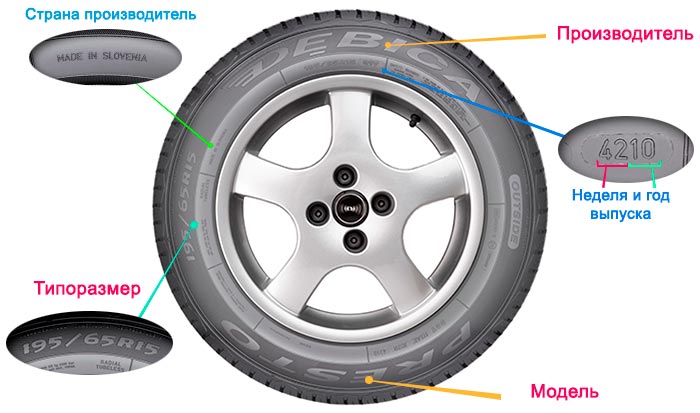
In addition to the tire size, the brand name and model are applied on the side to identify the tires, for example: Nokian Hakka Green, Michelin Energy, Toyo Proxes, Good year Ultra Grip, Belshina BEL-347, Amtel NordMaster, Hankook K415 Optimo and others.
Inscription " Made in…» denotes the country of manufacture (Russia (Russia), Germany (Germany), USA (USA), France (France), China (China), etc.).
Year and week of issue on the tires is applied in a rounded oval with four numbers: for example, “0915” would mean that the tire was made on the 9th week of 2015.
Indices of allowable load and speeds

Load index(INS) - designation by numbers of the permissible load on the tire in kilograms. The value ranges from 0 (45 kg) to 279 (136000 kg). You can find out in detail which index you can in the table below:
| INS | MAX, kg | INS | MAX, kg | INS | MAX, kg | INS | MAX, kg | INS | MAX, kg | INS | MAX, kg | INS | MAX, kg |
|---|---|---|---|---|---|---|---|---|---|---|---|---|---|
| 0 | 45 | 40 | 140 | 80 | 450 | 120 | 1400 | 160 | 4500 | 200 | 14000 | 240 | 45000 |
| 1 | 46,2 | 41 | 145 | 81 | 462 | 121 | 1450 | 161 | 4625 | 201 | 14500 | 241 | 46250 |
| 2 | 47,5 | 42 | 150 | 82 | 475 | 122 | 1500 | 162 | 4750 | 202 | 15000 | 242 | 47500 |
| 3 | 48,7 | 43 | 155 | 83 | 487 | 123 | 1550 | 163 | 4875 | 203 | 15500 | 243 | 48750 |
| 4 | 50 | 44 | 160 | 84 | 500 | 124 | 1600 | 164 | 5000 | 204 | 16000 | 244 | 50000 |
| 5 | 51,5 | 45 | 165 | 85 | 515 | 125 | 1650 | 165 | 5150 | 205 | 16500 | 245 | 51500 |
| 6 | 53 | 46 | 170 | 86 | 530 | 126 | 1700 | 166 | 5300 | 206 | 17000 | 246 | 53000 |
| 7 | 54,5 | 47 | 175 | 87 | 545 | 127 | 1750 | 167 | 5450 | 207 | 17500 | 247 | 54500 |
| 8 | 56 | 48 | 180 | 88 | 560 | 128 | 1800 | 168 | 5600 | 208 | 18000 | 248 | 56000 |
| 9 | 58 | 49 | 185 | 89 | 580 | 129 | 1850 | 169 | 5800 | 209 | 18500 | 249 | 58000 |
| 10 | 60 | 50 | 190 | 90 | 600 | 130 | 1900 | 170 | 6000 | 210 | 19000 | 250 | 60000 |
| 11 | 61,5 | 51 | 195 | 91 | 615 | 131 | 1950 | 171 | 6150 | 211 | 19500 | 251 | 61500 |
| 12 | 63 | 52 | 200 | 92 | 630 | 132 | 2000 | 172 | 6300 | 212 | 20000 | 252 | 63000 |
| 13 | 65 | 53 | 206 | 93 | 650 | 133 | 2060 | 173 | 6500 | 213 | 20600 | 253 | 65000 |
| 14 | 67 | 54 | 212 | 94 | 670 | 134 | 2120 | 174 | 6700 | 214 | 21200 | 254 | 67000 |
| 15 | 69 | 55 | 218 | 95 | 690 | 135 | 2180 | 175 | 6900 | 215 | 21800 | 255 | 69000 |
| 16 | 71 | 56 | 224 | 96 | 710 | 136 | 2240 | 176 | 7100 | 216 | 22400 | 256 | 71000 |
| 17 | 73 | 57 | 230 | 97 | 730 | 137 | 2300 | 177 | 7300 | 217 | 23000 | 257 | 73000 |
| 18 | 75 | 58 | 236 | 98 | 750 | 138 | 2360 | 178 | 7500 | 218 | 23600 | 258 | 75000 |
| 19 | 77,5 | 59 | 243 | 99 | 775 | 139 | 2430 | 179 | 7750 | 219 | 24300 | 259 | 77500 |
| 20 | 80 | 60 | 250 | 100 | 800 | 140 | 2500 | 180 | 8000 | 220 | 25000 | 260 | 80000 |
| 21 | 82,5 | 61 | 257 | 101 | 825 | 141 | 2575 | 181 | 8250 | 221 | 25750 | 261 | 82500 |
| 22 | 86 | 62 | 265 | 102 | 850 | 142 | 2650 | 182 | 8500 | 222 | 26500 | 262 | 85000 |
| 23 | 87,5 | 63 | 272 | 103 | 875 | 143 | 2725 | 183 | 8750 | 223 | 27250 | 263 | 87500 |
| 24 | 90 | 64 | 280 | 104 | 900 | 144 | 2800 | 184 | 9000 | 224 | 28000 | 264 | 90000 |
| 25 | 92,5 | 65 | 290 | 105 | 925 | 145 | 2900 | 185 | 9250 | 225 | 29000 | 265 | 92500 |
| 26 | 95 | 66 | 300 | 106 | 950 | 146 | 3000 | 186 | 9500 | 226 | 30000 | 266 | 97500 |
| 27 | 97,5 | 67 | 307 | 107 | 975 | 147 | 3075 | 187 | 9750 | 227 | 30750 | 267 | 97500 |
| 28 | 100 | 68 | 315 | 108 | 1000 | 148 | 3150 | 188 | 10000 | 228 | 31500 | 268 | 100000 |
| 29 | 103 | 69 | 325 | 109 | 1030 | 149 | 3250 | 189 | 10300 | 229 | 32500 | 269 | 103000 |
| 30 | 106 | 70 | 335 | 110 | 1060 | 150 | 3350 | 190 | 10600 | 230 | 33500 | 270 | 106000 |
| 31 | 109 | 71 | 345 | 111 | 1090 | 151 | 3450 | 191 | 10900 | 231 | 34500 | 271 | 109000 |
| 32 | 112 | 72 | 355 | 112 | 1120 | 152 | 3550 | 192 | 11200 | 232 | 35500 | 272 | 112000 |
| 33 | 115 | 73 | 365 | 113 | 1150 | 153 | 3650 | 193 | 11500 | 233 | 36500 | 273 | 115000 |
| 34 | 118 | 74 | 375 | 114 | 1180 | 154 | 3750 | 194 | 11800 | 234 | 37500 | 274 | 118000 |
| 35 | 121 | 75 | 387 | 115 | 1215 | 155 | 3875 | 195 | 12150 | 235 | 38750 | 275 | 121000 |
| 36 | 125 | 76 | 400 | 116 | 1250 | 156 | 4000 | 196 | 12500 | 236 | 40000 | 276 | 125000 |
| 37 | 128 | 77 | 412 | 117 | 1285 | 157 | 4125 | 197 | 12850 | 237 | 41250 | 277 | 128500 |
| 38 | 132 | 78 | 426 | 118 | 1320 | 158 | 4250 | 198 | 13200 | 238 | 42500 | 278 | 132000 |
| 39 | 136 | 79 | 437 | 119 | 1360 | 159 | 4375 | 199 | 13600 | 239 | 43750 | 279 | 136000 |
Tires destined for the North American market are also embossed with the parameter "Maximum Pressure", which is measured in pounds per square inch (1 PSI = 0.068046 atmospheres) and "Max Load", in pounds or kilograms. Max. press. means the maximum allowable pressure in cold tires, and Max. load- load.
Speed index- an indicator of the maximum allowable speed to which you can accelerate on tires. The value is indicated in Latin letters from A to Z and, accordingly, the speed limit is 5-300 km / h (there is no marking over 300 km / h).
| Index | m/h | km/h | Index | m/h | km/h | |
| A1 | 3 | 5 | L | 75 | 120 | |
| A2 | 6 | 10 | M | 81 | 130 | |
| A3 | 9 | 15 | N | 87 | 140 | |
| A4 | 12 | 20 | P | 94 | 150 | |
| A5 | 16 | 25 | Q | 100 | 160 | |
| A6 | 19 | 30 | R | 106 | 170 | |
| A7 | 22 | 35 | S | 112 | 180 | |
| A8 | 25 | 40 | T | 118 | 190 | |
| B | 31 | 50 | U | 124 | 200 | |
| C | 37 | 60 | H | 130 | 210 | |
| D | 40 | 65 | V | 149 | 240 | |
| E | 43 | 70 | Z/ZR | over 149 | over 240 | |
| F | 50 | 80 | W | 168 | 270 | |
| G | 56 | 90 | (W) | over 168 | over 270 | |
| J | 62 | 100 | Y | 186 | 300 | |
| K | 68 | 110 | (Y) | over 186 | over 300 |
Read more about tire indexes here.
Tire design
All design features of the wheels are often also marked on the sidewall.
Radial or diagonal tires
As mentioned earlier, radial tires are marked with the letter “R” in the main size index or the inscription “Radial”, and for diagonal tires this letter is simply absent. The difference between these tires lies in the arrangement of the cords, which increase the torsional stiffness and stress on the tire. In diagonal tires, the steel threads go intertwined at right angles, and in radial threads they are evenly spaced from the edge of one bead to the other.

What is the best tire design?? Radial tires are more resistant to wear than diagonal tires - they are able to cover more than 60,000 km, while their competitor barely manages half as much mileage. In addition, the stability and handling of diagonal tires is worse, however, as is the rolling resistance, which affects increased fuel consumption. The design of the radial tire also includes a breaker that reinforces the rigidity of the sidewall. Such slopes help to achieve a more stable and larger contact patch with the road. Almost all modern tires are radial.
Tube and tubeless tires
Tires labeled "Tubeless" or TL are called tubeless. In such tires, air is directly pumped through the nipple.
Tube tires are labeled "Tube Type" or TT. In such slopes, air is pumped into a rubber chamber, which is installed inside the tire.
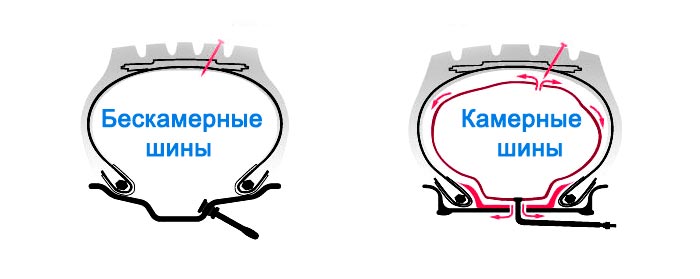
Tubeless tires have a number of advantages over their outdated counterparts:
- Less weight due to the absence of a chamber and a simplified design.
- When punctured, tubeless tires descend much more slowly.
- They overheat less and, as a result, break down more slowly.
Other design features
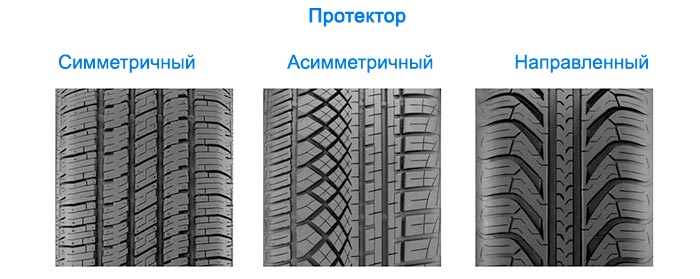
Seasonality and type of coverage
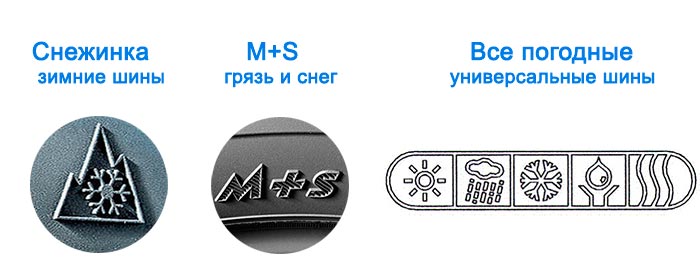
- All Seasons, As put on the outside of all-weather, that is, those that can be used both in winter and summer.
- R+W (Road+Winter) marking of slopes intended for ordinary roads and winter conditions, another subspecies of all-weather
- Any Weather tires designed for all weather.
- M+S, M&S or M.S means "Mud and Snow" (Mud and Snow), tires designed for winter weather and melted snow in particular.
- Snowflake- a badge against the background of three mountain peaks is applied to the sidewall of winter tires. Manufacturers whose tires have passed the grip test 10% better than the Uniroyal Tiger reference can apply for this marking.
- Umbrella pictogram or inscriptions Aquatred, Aquacontact applied to tires designed for rain.
Wear
Many manufacturers took care of the end consumer and installed a wear indicator on tires. Its presence on the tire is indicated by the inscription Tread Wear Indication or TWI. Each brand in its own way decided to show the tread depth, for example:
- Michelin install a triangle on the top of the sidewall, which shows exactly where the wear indicator is located.
- Nokian, Matador and many other companies cut out numbers on the tread that indicate the depth of the tread in millimeters, as the tire gradually wears out, the layer is erased from one number to another
- The rest of the brands in the tread grooves put a perpendicular partition, the height of which will indicate that the tire is completely worn out.
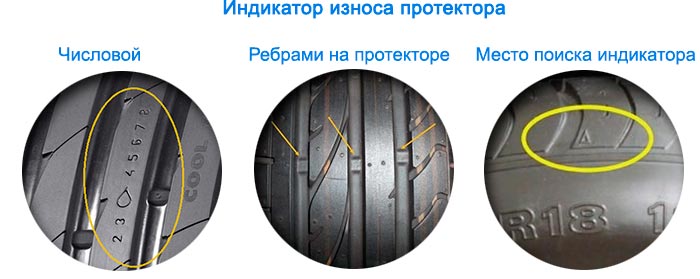
The minimum allowable wear for passenger cars is 1.6 mm, which is valid both in Russia and in all European countries. It is believed that this is the last frontier, which somehow prevents the tire from hydroplaning in puddles.
The tread depth of new summer slopes is usually 7-8 mm, winter 8-10, depending on the type of pattern.
Compliance

Tires that are produced in the CIS countries and Russia in particular have inscriptions indicating that they belong to state standards or certain technical conditions. On the sidewall, they are applied with a document code, for example: GOST 4754-97 or TU2521-036-00148984-98. In addition, tires certified in Russia are sometimes marked with the PCT mark, which indicates the presence of a certificate.
Tires destined for the European market are embossed with the UNECE N30 regulation mark. The number in the circle is the country code, and outside the standard designation, for example E4 0220984.
Tires produced for the North American market are marked DOT (Department of Transportation USA), which consists of an alphanumeric code that encrypts the manufacturer, slope size, manufacturer, for example DOT M746 JR1R.
Color markings
In addition, each manufacturer, for its own convenience or specific needs, can apply different own marks for each tire.
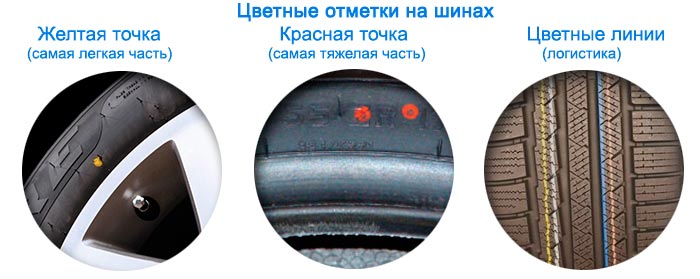
- yellow marks put on the lightest part of the tire, as a place to install the nipple, simplifying the work of tire fitting.
- Red mark on the tire indicates the place of the greatest heterogeneity or the heaviest part.
- Colored stripes on the tread a variety of colors are created to simplify logistics and help distribute tires to warehouses.
- white circle with number on the sidewall, this is a sign corresponding to the Soviet Quality Control Department (technical control department), which means a check in the warehouse by the supplier.
Tire sticker
One of the new tire marking trends is stickers that are stuck on the tread before being sold. On them you can find out the rolling resistance, noise and braking of a car on wet pavement.
- rolling resistance or RRC (Rolling Resistance Coeficient) is measured in the letter A, B, C, D, E, F, G. A is considered the best, which means the lowest coefficient. The remaining letters increase the fuel consumption on the reference car with a consumption of 6.6 l / 100 km.
- Braking on wet pavement as in the previous example, they are measured in letters of the Latin alphabet: A, B, C, D, E, F, G, where the letter A will mean the shortest braking distance on wet asphalt.
- Tire noise is indicated by a speaker icon with a tire and an applied dB level. If all sound waves are filled with black, then the slope has 75 dB or more, which will be prohibited in the EU from 2016.

If you have read this article to the end, congratulations, you can confidently consider yourself an expert in tire markings.
Tire marking decoding was last modified: April 25th, 2017 by abc-tyre







